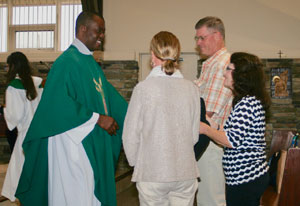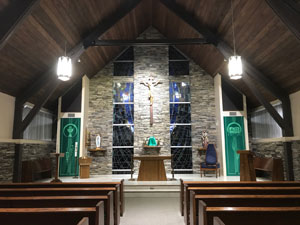CHARLOTTE — More than 500 catechists and ministry leaders from throughout western North Carolina attended the Diocese of Charlotte’s second annual Catechetical Conference, held Nov. 4 at the Charlotte Convention Center.
The conference, organized by the diocese’s Education Vicariate and partly funded by the Diocesan Support Appeal, was designed to provide teachers and faith formation leaders with resources, information and inspiration to help their students – youth and adults alike – become strong disciples of Christ.
The conference opened with a bilingual Mass celebrated by Bishop Peter Jugis. Father Julio Dominguez concelebrated.
In his homily, Bishop Jugis spoke of St. Charles Borromeo, whose feast was commemorated that day. The archbishop of Milan’s devotion to education in response to the widespread confusion of the Reformation – when clarity about the Catholic faith was needed – serves as a model for Catholic teachers in today’s confusing times, he said.
St. Charles Borromeo edited the catechism that sprung from the Council of Trent, founded some of the Church’s first modern seminaries to train priests, and was the first to establish the Confraternity of Christian Doctrine (CCD) throughout his diocese. CCD has been a religious education program for Catholic children since 1562.
All of St. Charles Borromeo’s accomplishments, though, are not the reason why he’s recognized as a saint, Bishop Jugis said. He’s a saint because of “his personal holiness and his union with Jesus.”
That is “an important message we can draw from,” the bishop said, and he encouraged those present to focus on strengthening their personal relationship with Jesus before then teaching others: “First to know Jesus oneself, to be growing in an intimate friendship with Jesus, and then to be able to help our young people themselves to know Jesus and for them to grow in their intimate friendship with Jesus.”
“It’s all, of course, about Jesus,” he said, “knowing Him and forming strong disciples who are capable of following Him – not only just knowing what He teaches, but with their heart and their whole being following Jesus as disciples.”
Spend time in Eucharistic Adoration, he encouraged participants, to deepen that relationship with Jesus. Their “strong witness” and devotion to personal prayer, he said, will inspire others to follow Christ.
Catechists attending the conference said they were excited to spend time learning from each other and finding ways to improve or enliven their ministry, whether it’s teaching children in faith formation classes or adults in the RCIA program.
Nicole Waer, director of religious education for Holy Spirit Church in Denver, said she was particularly interested in applying the conference’s theme, “Living as Missionary Disciples,” in her parish’s growing youth programs.
Keynote addresses were given by Sister Mary Johanna Paluch, professed with the Sisters of St. Francis of the Martyr St. George and an associate theology professor at Franciscan University, and Esther Terry, director of the Camino program at the University of Notre Dame’s McGrath Institute for Church Life.
Both keynote speakers talked about the Catechism of the Catholic Church, encouraging everyone to read it and pray with it, not just use it as an occasional reference tool.
This is the 25th anniversary of the Catechism, which was promulgated by St. John Paul II in 1992. It sums up, in book form, the beliefs of the Catholic Church, but Sister Johanna noted with a smile, “Nobody reads it. People think it’s only for bishops.”
But, she emphasized, “The catechism is for everybody.”
It is the definitive resource for teaching the Catholic faith, second only to Sacred Scripture, she said. And the current Catechism is not a random invention, but instead a compilation designed for today’s audiences that is built on catechisms dating all the way back to St. Irenaeus and St. Augustine.
More than simply “words printed on a page,” the Catechism presents the truths of the Catholic faith in a concise, understandable way so that Catholics can better know Jesus and become His disciples – and that’s really what teaching the faith is all about, Sister Johanna said.
“Please, please read the Catechism! Find Jesus in the Catechism! Find your faith in the Catechism!” she urged. “I promise you that you’ll love it and that your life will change.”
— Patricia L. Guilfoyle, Editor
 CHARLOTTE — For this month only, relics of several saints will be on display for veneration at St. Patrick Cathedral.
CHARLOTTE — For this month only, relics of several saints will be on display for veneration at St. Patrick Cathedral.
Father Christopher Roux, rector and pastor of the cathedral, displays the relics – some of which are from saints whose relics are not available anywhere else in the diocese – throughout November for public veneration.
The saints’ relics and their feast days are:
• St. Jean Marie Vianney – Aug. 4
• St. Francis of Assisi – Oct. 4
• Sts. Jacinta and Francisco Marto – Feb. 20
• St. Jude the Apostle – Oct.28
• 6 Passionist Saints:
o Paul of the Cross – Oct. 20
o Gabriel of Our Lady of Sorrows – Feb. 27
o Gemma Galgani - April 11
o Bl. Dominic Barberi – Aug. 27
o Maria Goretti - July 6
o Vincent Strambi – Sept. 26
• St. Stanislaus Kostka – Aug. 15
• St. Therese of the Child Jesus – Oct. 1
• St. Isidore - May 15
St. Patrick Cathedral is located at 1621 Dilworth Road East in Charlotte. For St. Patrick Cathedral’s Mass schedule and more information, go to www.stpatricks.org.
— Catholic News Herald
 ASHEVILLE — On a cold and rainy Saturday in downtown Asheville, parishioners from Catholic churches in the Asheville Vicariate hosted an Interfaith Prayer Service for Immigration.
ASHEVILLE — On a cold and rainy Saturday in downtown Asheville, parishioners from Catholic churches in the Asheville Vicariate hosted an Interfaith Prayer Service for Immigration.
More than 160 people from eight churches came together to pray Oct. 28 and listen to emotional stories of young immigrants who now live their lives in uncertainty, not knowing if they will be allowed to remain in the United States under the Deferred Action for Childhood Arrivals program or if they will be deported to a country they left when they were children.
People prayed for God's intercession for a just and merciful solution, and they committed themselves to supporting all immigrant families in the community.
Aztec dancers from St. Lawrence Basilica also performed during the service. The prayer service was held to show support and solidarity with the immigrant community in Asheville and to call on all people of faith to advocate for just immigration laws and policies.
— Photos provided by Nicholas Haskell
More online:
We Are Strangers No Longer: A Pastoral Statement of the Asheville Vicariate Council of the Catholic Diocese of Charlotte - 2017
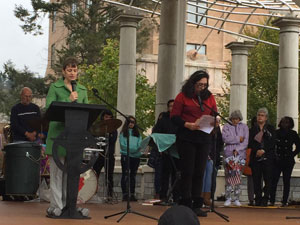
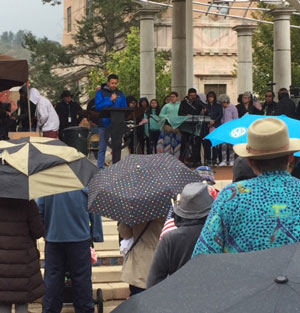

 CHARLOTTE — Kathy Capps and Phyllis Mennitt stroll through “Main Street” of Thomasboro Academy armed with a push wagon of hand-baked goods and a shopping cart of store-bought treats. Smiles gleam on their faces while they receive a celebrity greeting from their biggest fans, the children and teachers of Thomasboro Academy.
CHARLOTTE — Kathy Capps and Phyllis Mennitt stroll through “Main Street” of Thomasboro Academy armed with a push wagon of hand-baked goods and a shopping cart of store-bought treats. Smiles gleam on their faces while they receive a celebrity greeting from their biggest fans, the children and teachers of Thomasboro Academy.
Hugs and kisses come from all directions while teachers surround “The Angels” in search of their favorite butter pecan cupcake or double-dipped chocolate cake slice. The teachers look at “The Angels” with a smile and a shake of their head as if the cupcakes are Tylenol, and the “We Care” Team are nurses providing relief.
“When I see them, I know someone let the sunshine through the doors. These ladies have been with us for as long as I can remember, ever since I’ve been here,” claims Academic Facilitator Lori Rondo.
Pictured: Phyllis Mennitt and Kathy Capps of St. Luke Church, pictured with teacher Meghan Bernhard, are among “The Angels” who visit Thomasboro Academy on a regular basis, brightening the day for students and teachers. (Lisa Geraci |Catholic News Herald)
Each Friday morning the “We Care” Team, comprised of Phyllis Mennitt, Ann Marie Luce, Olga Monroe, Marlene Perotta, Fatima Robaina and Kathy Capps, drives from Matthews to Thomasboro Academy to serve the kindergarten to eighth-grade classes. Each teacher receives a baked item, class snacks for each student, and classroom supplies. Even the cafeteria workers and custodians get a snack. Two of the eighth-graders help distribute the snacks with “The Angels.” Some volunteers, such as Luce, go into the classroom and help the students learn to read while the team continues to distribute the snacks. The whole process starts around 11 a.m. and takes about two-and-a-half hours.
“Sometimes we laugh all the way home, sometimes we cry,” Mennitt says.
Destiny, a seventh-grade student “The Angels” have known since kindergarten, dances her way down the hallway, jumping up to give Kathy a hug and a kiss on the cheek. “I love you!” she says, clinging to Capps’ neck. Destiny does not take a treat right away, but marvels at all the choices.
The affection that Capps and Mennitt display with the children is true and palpable – the reason they have pet names such as “Mom” and “St. Luke’s Angels.”
As the middle-school students walk down the hall in a single-file line, “The Angels” call out the name of a boy. No matter how “cool” he tries to appear, the second he looks up, he melts at the sight of Capps and Mennitt, as if it was the first time he saw them as a kindergartner. His eyes grow big, a smile peeps out, and he breaks the line for a hug.
The kindergartners are adorable and love “The Angels” and their cart, too, but the older students have gotten to know “The Angels” on a different level, spending holidays, having parities, eating dinners, opening presents, sharing conversations. For them, the St. Luke parishioners are more than great bakers who come over to pass out snacks every Friday. They represent stable figures of joy and love.
For the new teachers at Thomasboro Academy, “The Angels” are a weekly reminder of love, support and thanks.
“We do this so they can look forward to something. The teachers have so much pressure on them. There is minimal parent involvement. Everyone in the community wants to tell them what to do and how to do it, but does not really understand the reality of what is truly happening inside these walls,” Capps says.
“On top of all that, they have bills and their own problems. Many of the teachers are single and young; a lot of them actually call us “mom.” The teachers and I are in constant contact even when I am not there. We are texting and emailing, chatting about school.”
“Sometimes the teachers need more hugs than the students,” says teacher Tamika Truesdale. “Everyone has their own unique relationship with Kathy.”
“She is one of kind,” she adds after having a lengthy conversation about her son and husband. “Make sure you text me those pictures,” she reminds Capps before closing her door, rice crispy treat in hand.
“Thomasboro is not the typical school,” Capps says. Despite the smiling faces of the students, dressed in their nicely pressed uniforms, Thomasboro is located in an environment that demands constant love, support, guidance and patience.
Out of the 800 students at Thomasboro Academy, 99.6 percent are classified as economically disadvantaged, and about 20 percent either homeless or in a transitional housing situation. The school received an “F” for the 2016-2017 school year, a state rating solely on end-of-grade scores and standardized test proficiency.
But the level of commitment from the administrators, teachers, community and even the students themselves tells another story – a story of hope and of overcoming obstacles.
“Thomasboro is the best and the worst experience all at the same time,” Capps says. “Some people just can’t handle it. They try to eat lunch and work in the classroom, but it was just not a fit. You can’t be judgmental. You have to roll with the punches. Whatever the child needs from the social workers, to the teachers, to the administrators, to us, we are ready.”
“This all started about 14 years ago when my daughter was in first grade and went to elementary school at Elizabeth Lane. Elizabeth Lane just adopted ‘a sponsor school,’ Thomasboro. All we knew about it was that it was a high-need school,” Capps explains.
“I started there as a lunch buddy. I ate with a girl that was also in first grade just like my girl. That first girl did it. They were all desperately craving attention. They just wanted someone to listen to their stories and hug them. I just fell in love with the whole class.”
As her relationship with the class grew stronger, she started to realize, “These pint-sized kids had adult-sized problems. Instead of ‘I need a pencil,’ it would be more like, ‘I don’t know where I’m going to sleep tonight.’ Many of the students had behavioral issues. Some were never able to apologize, they had their guard up, they were angry. Deep down they were just kids that desired to soften up and open up.
“I knew I found my place and this is where I could make a difference,” she says.
“But this is more about St. Luke than me,” she continues. “Without St. Luke it would have stayed low-key, but St. Luke has made it possible for this movement to grow. I am so awed and inspired by the whole church. During the first visit to Thomasboro, I noticed it was cold and the kids had no coats and small shoes. Straight after, I went to St. Luke’s and asked Father Jim (Hawker) if they could possibly do a clothing drive. St. Luke started collecting clothes immediately. Fourteen years later, we are still collecting supplies, food, shoes and uniforms, in a wooden crate, in the back of the church, marked ‘Thomasboro’.”
During the fall months, Kathy started casually discussing Halloween plans with the kids. The kids got a laugh out of that. They were not going trick-or-treating because the area was too dangerous. Plus, they didn’t have anyone take them. They didn’t have enough money for costumes or candy.
“It made me think – Halloween was such a little thing that kids take for granted, but these kids were really missing out on their childhood, their memories,” Capps says.
St. Luke parishioners came to rescue, and the parish youth group started making treat bags to give to the kids for Halloween.
“Then we just started adding on for each holiday. For Thanksgiving we started making sure needy families had a turkey. During Christmas, we bought every single child attending Thomasboro a gift.
“We started small, but currently, the Knights of Columbus does the food for Christmas, the youth group does the Halloween treats, Faith Formation collects hats and gloves. ‘Young at Heart’ helps with something every month, and the Hispanic community helps with our ‘We Care’ budget.
“Every ministry at St. Luke has found a way to come through for these kids,” Capps says.
“This is an amazing story, I never saw coming and it would not have happened if it was not for the help of St. Luke,” she adds.
“This whole experience has been life-changing. I am still in contact with the very first girl I sat down with for lunch, as well as other students from that class who have gone to college or are working. It is unusual for a partnership to last this long.
“It started out as volunteering and now we are family, year ’round.”
Says one teacher as he grabs a slice of pumpkin swirl cake from the wagon being pushed by “The Angels,” “They are just the lift we need around here.”
— Lisa Geraci, correspondent
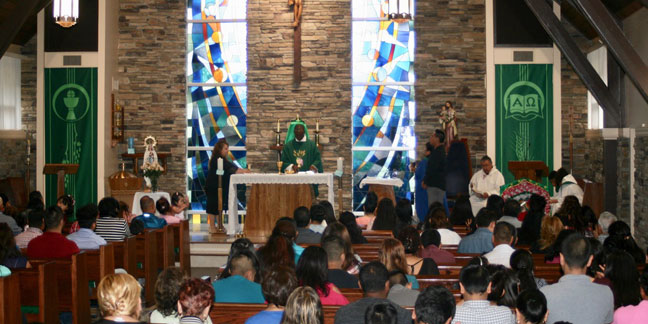 LEXINGTON — On Oct. 7, their parish’s patronal feast day, members of Our Lady of the Rosary Church gathered to celebrate the successful completion of an extensive church remodeling effort led by the parishioners themselves.
LEXINGTON — On Oct. 7, their parish’s patronal feast day, members of Our Lady of the Rosary Church gathered to celebrate the successful completion of an extensive church remodeling effort led by the parishioners themselves.
They gathered for Mass, offered by Father Ambrose Akinwande, pastor, to give thanks to God for everyone who labored to make the project a reality, and they marveled at the beauty of the refurbished nave and sanctuary.
“If I hadn’t seen this church from the outside, I would have never dreamed it was the same church,” said visitor Ted Young, who came in to help move the organ, one of the larger components of the project.
The renovation began as a straightforward beautification project for the 75-year-old church – fresh paint and new carpeting, etc. – but the scope expanded as parishioners’ enthusiasm for the idea grew.
Parishioners ended up completely remodeling the nave: removing the cry room and repositioning the organ and choir on a new raised platform at the rear of the church; installing new carpeting; repainting the walls and enhancing them with local cultured stone; and replacing the nondescript drywall ceiling with planks of southern pine that were stained a dramatic dark brown. In the sanctuary, the carpeting was replaced with a highly reflective white porcelain tile to pick up the beautiful light streaming through the tall stained glass windows behind the altar.
Parishioners chipped in with their own labor, saving thousands of dollars, and they worked for three years to raise money from special events for the project, which totals an estimated $70,000.
Gail and Kenny Capone spearheaded golf tournaments at the Asheboro Country Club and silent auctions in order for the renovation project to begin. The parish’s Hispanic community also raised funds from several festivals it hosted. The parish also used $46,520 of its “Forward in Faith, Hope, and Love” campaign money on the project.
Said Gail Capone, “We first set out to raise enough money for paint and new carpet, and look at how much more there came to be. It’s all just so amazing and so beautiful.”
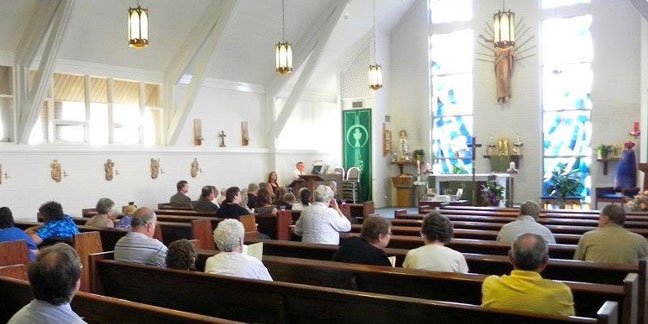 Once the parish had the money it needed for the renovation project, Father Akinwande and parishioner John Bloxsom consulted with the Diocese of Charlotte Properties Office to finalize the designs, select materials, and line up teams of stonemasons, electricians, painters and more to see the project through.
Once the parish had the money it needed for the renovation project, Father Akinwande and parishioner John Bloxsom consulted with the Diocese of Charlotte Properties Office to finalize the designs, select materials, and line up teams of stonemasons, electricians, painters and more to see the project through.
Bloxsom is grateful to Morlando for his guidance throughout the project. “His expertise was invaluable, and really made the project flow,” he said.
Parishioners did all the demolition work starting in June. They also sanded and stained all of the ceiling planks – a savings of nearly $6,000 alone. They removed all the pews for the carpet to be installed, then put them all back in place and did the final cleaning just in time for the parish’s feast day celebration.
Father Akinwande and Bloxsom said they have been simply amazed at how many people from all walks of life came together to beautify Our Lady of the Rosary Church.
“Just the fact that we can all look up at the ceiling for many years to come and say that we had a hand in that…we all stained those planks,” noted Bloxsom’s wife Karen.
“Momentum really began to build and many people stepped forward to donate additional funds in their enthusiasm and joy after seeing such good things taking place at their house of worship,” Father Akinwande said.
Bloxsom noted that the project ended up being about more than beautifying a church: it became a unifying force for the parish.
“As the project progressed, people got excited,” he said. Coming together to stain the ceiling planks, move the pews, clean the church and so much more, gave English- and Spanish-speaking parishioners the opportunity to get to know each other better, share meals, and have fun.
“It is beautiful, if I do say so myself,” he said.
— Julia Fredrica Foy Michaels, correspondent
